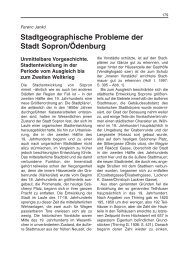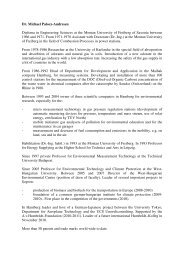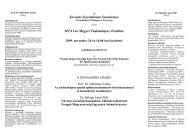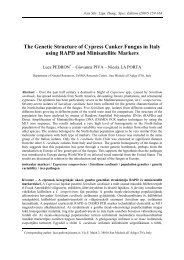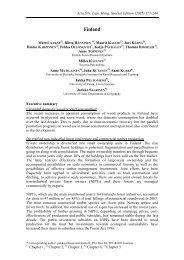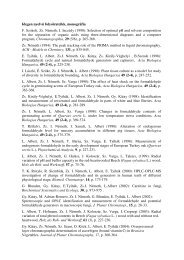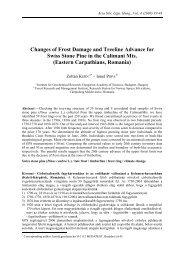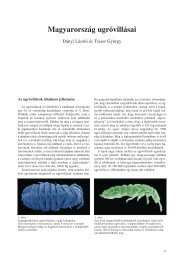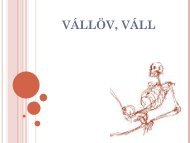On the Biology of the Bark Beetle Scolytus nitidus Schedl ...
On the Biology of the Bark Beetle Scolytus nitidus Schedl ...
On the Biology of the Bark Beetle Scolytus nitidus Schedl ...
Create successful ePaper yourself
Turn your PDF publications into a flip-book with our unique Google optimized e-Paper software.
Acta Silv. Lign. Hung., Vol. 3 (2007) 65-74<br />
<strong>On</strong> <strong>the</strong> <strong>Biology</strong> <strong>of</strong> <strong>the</strong> <strong>Bark</strong> <strong>Beetle</strong> <strong>Scolytus</strong> <strong>nitidus</strong> <strong>Schedl</strong><br />
(Coleoptera: Scolytidae) Attacking Apple Orchards<br />
Abdul Ahad BUHROO a* – Ferenc LAKATOS b<br />
a Postgraduate Department <strong>of</strong> Zoology, University <strong>of</strong> Kashmir, Hazratbal, Srinagar–190006 (India)<br />
b Institute <strong>of</strong> Sylviculture and Forest Protection, University <strong>of</strong> West Hungary, Sopron, Hungary<br />
Abstract -– The biological characters <strong>of</strong> <strong>Scolytus</strong> <strong>nitidus</strong> were investigated both in <strong>the</strong> field and in <strong>the</strong><br />
laboratory as well. This common shot-hole borer overwinters in larval stage on apple trees in Kashmir.<br />
After emergence <strong>the</strong> adults fly to suitable trees and undergo maturation feeding for 4-6 days. The<br />
copulation takes place at <strong>the</strong> entrance hole. The maternal gallery is one armed longitudinal, in average<br />
4.6 cm long. The female lays 52 eggs on an average. The eggs hatch in 5 to 7 days. The larvae have 5<br />
instars and complete <strong>the</strong>ir development in 38 to 50 days constructing larval galleries 5-8 cm in length.<br />
The larvae pupate for 6-18 days and finally <strong>the</strong> adults emerge to attack new suitable trees. The adults<br />
live for 45-60 days and <strong>the</strong> total life-span <strong>of</strong> this species ranges from 97 to 124 days. The seasonal<br />
distribution <strong>of</strong> various life stages and <strong>the</strong> number <strong>of</strong> generations were also recorded.<br />
Bionomics / <strong>Scolytus</strong> <strong>nitidus</strong> / Scolytidae / apple trees<br />
Kivonat – Az almafán károsító <strong>Scolytus</strong> <strong>nitidus</strong> <strong>Schedl</strong> (Coleoptera: Scolytidae) biológiája. Egy,<br />
az almafán károsító szúfaj, a <strong>Scolytus</strong> <strong>nitidus</strong> biológiai jellemzőit vizsgáltuk terepi és laboratóriumi<br />
körülmények között. A faj India Kasmír tartományában igen gyakori. Lárva alakban telel át<br />
gazdanövényén. A tavaszi kibújás után a nemzők megfelelő gazdanövényt keresnek és 4-6 napon át érési<br />
rágást végeznek. Ezt követi a párosodás. Az anyamenet egykarú, hosszirányú, átlagosan 4,6 cm<br />
hosszúságú. A nőstény bogár átlagosan 52 tojást rak le. A tojásból 5-7 nap múlva bújnak ki az álcák. Az<br />
álcastádium 38-50 napig tart, mialatt az ötször vedlő álcák 5-8 cm hosszúságú álcamenetet készítenek. A<br />
bábnyugalom 6-18 napig tart, amely után a frissen kifejlődő nemzők kirajzanak és költésre alkalmas fát<br />
keresnek. A nemzők 45-60 napig élnek, míg a faj teljes élettartama 97-124 nap közötti. A különböző<br />
fejlődési alakok pontos megjelenési idejét, valamint a generációk számát is meghatároztuk.<br />
Biológia / <strong>Scolytus</strong> <strong>nitidus</strong> / Scolytidae / Malus domestica<br />
1 INTRODUCTION<br />
The scolytids are <strong>of</strong> great economic importance to forestry and horticulture in <strong>the</strong> temperate<br />
climatic zones including <strong>the</strong> valley <strong>of</strong> Kashmir. <strong>Scolytus</strong> <strong>nitidus</strong> <strong>Schedl</strong> is a predominant shot-hole<br />
borer which has caused considerable losses to fruit trees in <strong>the</strong> fruit growing areas <strong>of</strong> <strong>the</strong> valley<br />
since 1961 (Malik 1966) and its population has increased enormously during <strong>the</strong> past decade due<br />
to favourable environmental conditions, mainly, drought. <strong>On</strong> an average 5-10 per cent apple trees<br />
* Corresponding author: draab@rediffmail.com; University <strong>of</strong> Kashmir, Srinagar-190006
66<br />
Acta Silv. Lign. Hung. 3, 2007<br />
Buhroo, A.A. – Lakatos, F.<br />
get damaged annually by <strong>the</strong> attack <strong>of</strong> this bark beetle species, which can increase upto<br />
44 per cent in <strong>the</strong> mismanaged orchards during dry and hot wea<strong>the</strong>r conditions. The main<br />
damage to <strong>the</strong> tree is caused by adults entering <strong>the</strong> main branches and twigs during maturation<br />
feeding. After beetle attack, <strong>the</strong> infested branches or sometimes <strong>the</strong> entire tree may be killed<br />
during <strong>the</strong> establishment <strong>of</strong> <strong>the</strong> mo<strong>the</strong>r and larval galleries.<br />
<strong>Scolytus</strong> <strong>nitidus</strong> is distributed in <strong>the</strong> Himachal Pradesh, Kashmir & Uttar Pradesh <strong>of</strong> India<br />
and Xizang (Tibet) <strong>of</strong> China on host trees – Juglans regia, Prunus armeniaca, Pyrus malus &<br />
Cotoneaster microphylla (Wood and Bright 1992). There is no systematic information on <strong>the</strong><br />
various aspects <strong>of</strong> S. <strong>nitidus</strong> on temperate fruit tree species in Indian subcontinent except few<br />
reports <strong>of</strong> its occurrence in Kashmir (Beeson 1941, Malik 1966, Ahmad and Bhat 1987). The<br />
life history and behaviour <strong>of</strong> S. <strong>nitidus</strong> are complex and <strong>the</strong>re is no detailed account <strong>of</strong> its<br />
biology since its taxonomic description by <strong>Schedl</strong> (1957).<br />
Therefore, <strong>the</strong> objective <strong>of</strong> <strong>the</strong> present study was to investigate <strong>the</strong> detailed biology <strong>of</strong><br />
S. <strong>nitidus</strong> in Kashmir apple orchards.<br />
2 MATERIALS AND METHODS<br />
2.1 Field studies<br />
The biological data were obtained mainly from <strong>the</strong> study areas at Hazratbal, district Srinagar and<br />
from Bagh in Bandipora district consisting mainly apple trees. At both places, <strong>the</strong> orchards were<br />
having 20-45 years old trees with many cultivars like Red Delicious, Royal Delicious, Golden<br />
Delicious, American Apirouge, White Dotted Red, Benoni, Coxe’s Organge Pippen, Lal Farosh,<br />
Razakh War, Chamura, Saharunpuri, Red Gold, Crimsen etc. Some felling had been done in <strong>the</strong><br />
orchards in <strong>the</strong> previous year to initiate infestation by S. <strong>nitidus</strong>. In <strong>the</strong> following year trap logs<br />
were also put out as per <strong>the</strong> methods <strong>of</strong> Beaver (1967). These trap logs were cut periodically from<br />
April to September each year from 2000 to 2002. Observations <strong>of</strong> <strong>the</strong> various life stages were<br />
made once or twice weekly throughout <strong>the</strong> season on <strong>the</strong> trap logs and o<strong>the</strong>r infested branches <strong>of</strong><br />
standing trees. New galleries were marked with a white dot. Fur<strong>the</strong>r information was obtained by<br />
careful removal <strong>of</strong> bark sections both in <strong>the</strong> field and in <strong>the</strong> laboratory.<br />
At <strong>the</strong> Bandipora experimental site <strong>the</strong> entrance holes, that <strong>the</strong> newly emerged beetles<br />
started grooving, were marked on one main branch and some twigs <strong>of</strong> a declining apple tree<br />
(Red Delicious) during April-May. After <strong>the</strong> marking dates, 10 beetle entries were dissected<br />
each day and examined for eggs to determine female maturation feeding period.<br />
2.2 Laboratory rearing<br />
Three sizes <strong>of</strong> wooden rearing boxes <strong>of</strong> similar design were available for use in <strong>the</strong><br />
laboratory. The boxes were 30 × 30 × 30 cm, 46 × 46 × 46 cm and 25 × 30 × 36 cm in size<br />
having two screened, cross ventilated and three glass faces to facilitate entry <strong>of</strong> light. The<br />
branches naturally infested with S. <strong>nitidus</strong> were cut and placed in <strong>the</strong> rearing boxes. Fresh<br />
branches <strong>of</strong> 20-30 cm long and 2-4 cm in diameter were carefully removed from standing<br />
trees and <strong>the</strong>ir cut ends were sealed with wax. These uninfested branches were also put in<br />
<strong>the</strong>se rearing boxes 10-15 days before adult emergence in order to induce fresh attack on<br />
<strong>the</strong>m. This enabled <strong>the</strong> continuous rearing and examination <strong>of</strong> beetle development.<br />
Few infested branches were also debarked regularly to study <strong>the</strong> various stages <strong>of</strong> <strong>the</strong> beetle<br />
under <strong>the</strong> bark. Characters <strong>of</strong> <strong>the</strong> different developmental stages including egg, larva, pupa and<br />
adult were recorded. Larval instars were separated by head capsule measurements (Beaver 1967).<br />
Mating behaviour, oviposition and gallery systems were also studied. Thus, developmental<br />
processes and durations <strong>of</strong> <strong>the</strong> pest’s life stages were recorded and compared with <strong>the</strong> field results.
<strong>On</strong> <strong>the</strong> <strong>Biology</strong> <strong>of</strong> <strong>the</strong> <strong>Bark</strong> <strong>Beetle</strong> <strong>Scolytus</strong> <strong>nitidus</strong> <strong>Schedl</strong> Attacking Apple Orchards<br />
2.3 Scanning electron microscopy<br />
Morphological characters were determined using scanning electron microscopy. Specimens<br />
were first placed in buffered glutaraldehyde (2.5%) for 2 hours followed by buffer washing<br />
for overnight. After this <strong>the</strong> specimens were treated with osmium tetroxide (1.0%) and <strong>the</strong>n<br />
dehydrated in different alcoholic concentrations. In <strong>the</strong> next step specimens were kept in αamyl<br />
acetate for 10 minutes followed by Critical Point Drying for 25 minutes using CO2.<br />
After 2 days <strong>of</strong> open drying <strong>the</strong> specimens were mounted on stubs and coated with gold using<br />
<strong>the</strong> Vacuum Evaporator (HITACHI, HUS-5GB). Electron micrographs were taken with a S-<br />
3000H Scanning Electron Microscope (HITACHI, Japan).<br />
3 RESULTS AND DISCUSSION<br />
3.1 Mating behaviour<br />
After host tree selection, <strong>the</strong> female <strong>of</strong> S. <strong>nitidus</strong> started to bore a small shot-hole on <strong>the</strong> bark<br />
<strong>of</strong> a declining branch. As soon as few beetles attacked, more and more flying adults <strong>of</strong> both<br />
sexes were attracted soon. The male was observed to but with his head against <strong>the</strong> abdomen<br />
<strong>of</strong> <strong>the</strong> female in <strong>the</strong> gallery a few times and <strong>the</strong>n quickly turned round over <strong>the</strong> entry hole and<br />
copulation followed. Mating lasted for 30 to 90 seconds with an average <strong>of</strong> 57 seconds.<br />
However, mating lasts for 10-30 seconds in case <strong>of</strong> S. scolytus on elm trees (Beaver 1967). A<br />
female got mated several times by <strong>the</strong> same male or different males.<br />
3.2 Maturation feeding<br />
<strong>Bark</strong> dissections for female maturation feeding (Figure 1) showed that no eggs were collected<br />
from beetle entries on 1 st and 2 nd day; only 3/10 from 3-day-old entries yielded eggs; 6/10<br />
from 4-day-old and 5-day-old entries contained eggs; while 7/10 from 6-day-old entries<br />
contained eggs; but all <strong>the</strong> 10 <strong>of</strong> 7-day-old beetle entries contained eggs. This indicated that<br />
newly emerged females mostly fed and oviposited in 4 to 6 days in <strong>the</strong> field. Maturation<br />
feeding for S. mali on apple trees is also completed in 4 to 6 days (Rudinsky et al. 1978). The<br />
successful maturation feeding occurred mostly on weakened trees or those with some dead<br />
branches. The feeding sites were <strong>the</strong>n continued into <strong>the</strong> mo<strong>the</strong>r galleries.<br />
Entries with eggs<br />
10<br />
9<br />
8<br />
7<br />
6<br />
5<br />
4<br />
3<br />
2<br />
1<br />
0<br />
1 2 3 4 5 6 7<br />
Days (10 entries/day)<br />
Figure 1. Female maturation period <strong>of</strong> S. <strong>nitidus</strong><br />
67<br />
Acta Silv. Lign. Hung. 3, 2007
68<br />
3.3 Gallery patterns<br />
Acta Silv. Lign. Hung. 3, 2007<br />
Buhroo, A.A. – Lakatos, F.<br />
Mo<strong>the</strong>r gallery was made in an upward direction along <strong>the</strong> long axis <strong>of</strong> <strong>the</strong> attacked branch from<br />
which 50 to 70 larval galleries radiated, penetrating <strong>the</strong> inner bark and <strong>the</strong> sapwood surface. The<br />
vertical mo<strong>the</strong>r galleries ranged from 2.5 to 7.5 cm in length with a mean <strong>of</strong> 4.6 (± 1.45 SD) cm<br />
(Table 1). The larval galleries were measured to be 3-8 cm in length with a mean <strong>of</strong><br />
6.5 (± 1.41 SD) cm (Table 1). The mean difference in length between <strong>the</strong> mo<strong>the</strong>r gallery and<br />
larval gallery was found to be significant (P-value = 0.005). The mo<strong>the</strong>r galleries were made at<br />
equal distances from each o<strong>the</strong>r on <strong>the</strong> infested surface <strong>of</strong> <strong>the</strong> tree. The infested trunks and<br />
branches had thousands <strong>of</strong> exit-holes or shot-holes on <strong>the</strong> entire bark surface after <strong>the</strong> complete<br />
development.<br />
Table 1. Measurement for length <strong>of</strong> gallery systems<br />
Variable N<br />
Mean<br />
(mm)<br />
SD<br />
(mm)<br />
SEM<br />
(mm)<br />
Minimum<br />
(mm)<br />
Maximum<br />
(mm)<br />
Mo<strong>the</strong>r gallery 12 4.625 1.448 0.418 2.500 7.500<br />
Larval gallery 12 6.450 1.411 0.407 3.000 8.000<br />
N= Number <strong>of</strong> observations<br />
3.4 Life history<br />
<strong>Bark</strong> dissections showed that eggs were deposited in small individual chambers on both sides<br />
<strong>of</strong> <strong>the</strong> mo<strong>the</strong>r gallery at regular distances throughout its length. <strong>On</strong> an average 52 (± 6.81 SD)<br />
eggs were laid per female, approximately 26 on each side <strong>of</strong> <strong>the</strong> mo<strong>the</strong>r gallery (Table 2).<br />
Mo<strong>the</strong>r galleries were completed in 10-15 days but <strong>the</strong>reafter <strong>the</strong> female remained in <strong>the</strong><br />
tunnel until most <strong>of</strong> <strong>the</strong> larvae had developed. She finally died in <strong>the</strong> entrance hole. The egg is<br />
slightly oval, shining, pale white and minute about 0.64 (± 0.10 SD) mm in length and 0.48 (±<br />
0.07 SD) mm in width (Table 3). The eggs in <strong>the</strong> egg niches were covered by <strong>the</strong> boring dust.<br />
Table 2. Egg deposition by S. <strong>nitidus</strong><br />
Variable N Mean SD SEM Minimum Maximum<br />
Eggs 6 52.00 6.81 2.78 40.00 60.00<br />
N= Number <strong>of</strong> observations<br />
Table 3. Measurements for developmental stages <strong>of</strong> S. <strong>nitidus</strong><br />
Variable N<br />
Mean<br />
(mm)<br />
SD<br />
(mm)<br />
SEM<br />
(mm)<br />
Min.<br />
(mm)<br />
Max.<br />
(mm)<br />
Egg length 4 0.6449 0.0962 0.0481 0.5390 0.7700<br />
Egg width 4 0.4813 0.0667 0.0333 0.4235 0.5775<br />
Early larval length 4 0.7508 0.1618 0.0809 0.5775 0.9625<br />
Early larval width 4 0.4524 0.0910 0.0455 0.3850 0.5775<br />
Late larval length 3 5.7750 0.2700 0.1560 5.4670 5.9680<br />
Late larval width 3 1.8865 0.1019 0.0588 1.8095 2.0020<br />
Pupal length 4 4.0521 0.1584 0.0792 3.8500 4.2350<br />
Pupal width 4 1.5978 0.0497 0.0249 1.5400 1.6555<br />
Adult length 3 4.0040 0.1388 0.0801 3.8500 4.1195<br />
Adult width 3 1.6812 0.0588 0.0340 1.6170 1.7325<br />
N= Number <strong>of</strong> observations
<strong>On</strong> <strong>the</strong> <strong>Biology</strong> <strong>of</strong> <strong>the</strong> <strong>Bark</strong> <strong>Beetle</strong> <strong>Scolytus</strong> <strong>nitidus</strong> <strong>Schedl</strong> Attacking Apple Orchards<br />
The eggs hatched after an incubation period <strong>of</strong> 5-7 days (Table 4). The larva on hatching<br />
was a minute white dot almost motionless, measuring 0.75 (± 0.16 SD) mm in length and 0.45<br />
(± 0.09 SD) mm in width (Table 3). As soon as <strong>the</strong> feeding started <strong>the</strong> larva became curved,<br />
legless grub (Figure 2) and light creamy in colour. A full grown larva was 5.77 (± 0.27 SD)<br />
mm long and 1.89 (± 0.10 SD) mm wide (Table 3). The head capsule measurements<br />
(Figure 3) revealed that <strong>the</strong> larva passed through 5 instars before changing into pupa. The<br />
larval phase extended for 38-50 days (Table 4).<br />
Figure 2. Larva <strong>of</strong> S. <strong>nitidus</strong><br />
Table 4. Developmental durations <strong>of</strong> S. <strong>nitidus</strong> on apple during 1999-2002<br />
Developmental stage<br />
1<br />
Duration <strong>of</strong> generations (days)<br />
st 2 nd 3 rd (partial)<br />
Egg 6-7 5-6 6<br />
Larva 38-43 47-50 184-200 (overwintering)<br />
Pupa 8-10 6-8 14-18<br />
Adult 45-55 50-60 45-55<br />
Total 97-115 108-124 249-279<br />
69<br />
Acta Silv. Lign. Hung. 3, 2007
70<br />
Average length (mm)<br />
1,2<br />
0,8<br />
0,6<br />
0,4<br />
0,2<br />
Acta Silv. Lign. Hung. 3, 2007<br />
1<br />
0<br />
Buhroo, A.A. – Lakatos, F.<br />
0,241 0,385 0,577 0,693 1,001<br />
Average width (mm)<br />
Figure 3. Head capsule measurements for different larval instars <strong>of</strong> S. <strong>nitidus</strong><br />
The pupation took place at <strong>the</strong> ends <strong>of</strong> <strong>the</strong> larval galleries in pupal cells. The pupa<br />
(Figure 4) was s<strong>of</strong>t, white, averaging 4.05 (±0.16 SD) mm in length and 1.60 (± 0.05 SD) mm<br />
in width (Table 3). The pupal stage lasted for 6-18 days (Table 4).<br />
Figure 4. Pupa <strong>of</strong> S. <strong>nitidus</strong><br />
The adult emerged from <strong>the</strong> pupal chamber by tunnelling straight through <strong>the</strong> bark over<br />
it. After emergence, adults flew to <strong>the</strong> crown <strong>of</strong> o<strong>the</strong>r suitable trees to produce <strong>the</strong> next<br />
generation. The cylindrical adult (Figure 5, 6) averages 4.00 (± 0.14 SD) mm long and<br />
1.68 (± 0.06 SD) mm wide (Table 3). It has a shining black pronotum and dark red brown<br />
elytra with declivous abdomen (Figure 6). The second abdominal sternite ascends abruptly
<strong>On</strong> <strong>the</strong> <strong>Biology</strong> <strong>of</strong> <strong>the</strong> <strong>Bark</strong> <strong>Beetle</strong> <strong>Scolytus</strong> <strong>nitidus</strong> <strong>Schedl</strong> Attacking Apple Orchards<br />
and perpendicularly with a minute pointed tubercle in <strong>the</strong> middle near its posterior border<br />
(Figure 7). The adults lived for 45-60 days (Table 4).<br />
Figure 5. Adult <strong>of</strong> S. <strong>nitidus</strong> (dorsal view)<br />
Figure 6. Adult <strong>of</strong> S. <strong>nitidus</strong> (lateral view)<br />
71<br />
Acta Silv. Lign. Hung. 3, 2007
72<br />
3.5 Seasonal distribution<br />
Acta Silv. Lign. Hung. 3, 2007<br />
Buhroo, A.A. – Lakatos, F.<br />
Figure 7. Adult <strong>of</strong> S. <strong>nitidus</strong> (abdominal view)<br />
The results <strong>of</strong> <strong>the</strong> present observations (Figure 8) showed that S. <strong>nitidus</strong> overwintered in all<br />
<strong>the</strong> larval stages at <strong>the</strong> ends <strong>of</strong> <strong>the</strong>ir respective galleries from <strong>the</strong> end <strong>of</strong> November. The larvae<br />
remained inactive throughout <strong>the</strong> winter which resumed <strong>the</strong>ir activity from <strong>the</strong> first week <strong>of</strong><br />
March <strong>of</strong> <strong>the</strong> following year. Pupation started from <strong>the</strong> first week <strong>of</strong> April and <strong>the</strong> first<br />
swarming adults appeared from <strong>the</strong> third week <strong>of</strong> April. The species produced 3 generations<br />
(<strong>the</strong> last a partial one) per year in Kashmir (Figure 8). The first generation lasted from <strong>the</strong> last<br />
week <strong>of</strong> April to July having a total life span <strong>of</strong> 97-115 days (Table 4). The second generation<br />
occurred from <strong>the</strong> first week <strong>of</strong> July to <strong>the</strong> middle <strong>of</strong> October with a total life span <strong>of</strong> 108-124<br />
days while <strong>the</strong> third overwintering generation took about 249-279 days and was extended<br />
from September to May <strong>of</strong> <strong>the</strong> following year. It was also observed (Figure 8) that some late<br />
hatching larvae <strong>of</strong> second generation could not complete <strong>the</strong>ir development but overwintered<br />
as such in <strong>the</strong> last week <strong>of</strong> November and succeeded in completing 2 generations (<strong>the</strong> 2 nd a<br />
partial one) only. There was a considerable overlap <strong>of</strong> 2 nd and 3 rd partial generations. The<br />
adults can be seen throughout <strong>the</strong> emergence period as <strong>the</strong> adults <strong>of</strong> one brood <strong>of</strong> S. <strong>nitidus</strong><br />
have been reported to emerge for about 3 months (Buhroo et al. 2004). This can be due to<br />
different environmental factors, mainly, temperature to which <strong>the</strong> infested logs are exposed.<br />
Two generations <strong>of</strong> S. scolytus on elm (Beaver 1967) and also <strong>of</strong> S. mali on apple<br />
(Rudinsky et al. 1978) were described under European conditions. Both <strong>the</strong>se species<br />
overwinter in <strong>the</strong> larval stages. However, S. amygdali had 4 generations annually on fruit<br />
trees <strong>of</strong> Baluchistan (Janjua and Samuel 1941) and 5 generations per year on pear trees in<br />
Egypt (Kinawy et al. 1991). The developmental durations and generations <strong>of</strong> S. <strong>nitidus</strong> do not<br />
coincide with its related species worked out by o<strong>the</strong>r researchers (Beaver 1967, Janjua and<br />
Samuel 1941, Kinawy et al. 1991, Li-JiangLin et al. 1995, Mustaga 1991). The differences in <strong>the</strong>
<strong>On</strong> <strong>the</strong> <strong>Biology</strong> <strong>of</strong> <strong>the</strong> <strong>Bark</strong> <strong>Beetle</strong> <strong>Scolytus</strong> <strong>nitidus</strong> <strong>Schedl</strong> Attacking Apple Orchards<br />
life history <strong>of</strong> scolytid species can be explained by both species-specific variation and different<br />
environmental factors as well <strong>the</strong> variation <strong>of</strong> <strong>the</strong> biochemical composition <strong>of</strong> host trees.<br />
JAN FEB MAR APR MAY JUNE JULY AUG SEP OCT NOV DEC<br />
L<br />
P<br />
A 1 st E<br />
L<br />
P<br />
generation<br />
A 2 nd E<br />
L<br />
P<br />
generation<br />
A 3 rd E<br />
L<br />
generation<br />
4 CONCLUSIONS<br />
Figure 8. Seasonal distribution <strong>of</strong> S. <strong>nitidus</strong> on apple in Kashmir<br />
(E: egg, L: larva, P: pupa and A: adult)<br />
The common shot-hole borer <strong>Scolytus</strong> <strong>nitidus</strong> overwinters in larval instars at <strong>the</strong> ends <strong>of</strong> <strong>the</strong>ir<br />
respective galleries. After emergence in April-May <strong>the</strong> adults fly to <strong>the</strong> crown <strong>of</strong><br />
neighbouring trees and start maturation feeding for 4-6 days. Females start boring small<br />
entrance holes through <strong>the</strong> bark <strong>of</strong> declining branches to initiate copulation with <strong>the</strong> male.<br />
Mating takes 30 to 90 seconds. After being mated several times by one or more males at <strong>the</strong><br />
entrance hole, <strong>the</strong> female constructs mo<strong>the</strong>r gallery in an upward direction along <strong>the</strong> long axis<br />
<strong>of</strong> <strong>the</strong> attacked branch. The maternal gallery, in average 4.6 cm long, is made through <strong>the</strong><br />
phloem slightly grooving <strong>the</strong> sapwood surface. The female lays 52 eggs on an average. The<br />
eggs are placed in small individual chambers regularly spaced on both sides <strong>of</strong> <strong>the</strong> mo<strong>the</strong>r<br />
gallery and are surrounded by fine particles <strong>of</strong> wood-dust. The eggs hatch in 5-7 days and <strong>the</strong><br />
larval galleries radiate more or less away from <strong>the</strong> mo<strong>the</strong>r gallery and almost <strong>the</strong> entire<br />
phloem surface is eaten. The lengths <strong>of</strong> <strong>the</strong> larval galleries vary from 3 to 8 cm. The head<br />
capsule measurements show 5 instars during <strong>the</strong> larval phase which extends from 38 to 50<br />
days. The larvae pupate in pupal cells at <strong>the</strong> ends <strong>of</strong> <strong>the</strong>ir galleries. Pupal stage lasts for 6-18<br />
days. The pupal cells are cut in <strong>the</strong> phloem and outer bark or sometimes even in <strong>the</strong> outer<br />
layers <strong>of</strong> <strong>the</strong> sapwood. The adults live for 45-60 days. This species has two complete and a<br />
3rd partial generations per year in Kashmir.<br />
Acknowledgements: The present paper is a part <strong>of</strong> our joint research work financially<br />
supported by Indian National Science Academy and Hungarian Academy <strong>of</strong> Sciences under<br />
International Exchange Programme to whom we <strong>of</strong>fer our sincere thanks.<br />
REFERENCES<br />
AHMAD, D. – BHAT, M. R. (1987): Insect pests <strong>of</strong> apple trees in Kashmir. Geobios new Reports 6: 60-63.<br />
BEAVER, R. A. (1967): Notes on <strong>the</strong> biology <strong>of</strong> <strong>the</strong> bark beetles attacking elm in Wytham Wood,<br />
Berks. Entomologist’s Monthly Magazine 102: 156-162.<br />
73<br />
Acta Silv. Lign. Hung. 3, 2007
74<br />
Acta Silv. Lign. Hung. 3, 2007<br />
Buhroo, A.A. – Lakatos, F.<br />
BEESON, C. F. C. (1941): The ecology and control <strong>of</strong> <strong>the</strong> forest insects <strong>of</strong> India and <strong>the</strong> neighbouring<br />
countries. First published 1941, First Reprint 1961, Dehradun.<br />
BUHROO, A. A. – CHISHTI, M. Z. – MASOODI, M. A. (2004): Studies on <strong>the</strong> population dynamics <strong>of</strong> shothole<br />
borer <strong>Scolytus</strong> <strong>nitidus</strong> <strong>Schedl</strong> (Coleoptera: Scolytidae). The Indian Forester 130: 1451-1458.<br />
JANJUA, N . A. – SAMUEL, C. K. (1941): Fruit pests <strong>of</strong> Baluchistan. Imp. Coun. Agric. Res. Bull. 42: 12-28.<br />
KINAWY, M. M – TADORS, A. W. – ABDALLAH, F. F. (1991). <strong>On</strong> <strong>the</strong> biology <strong>of</strong> <strong>the</strong> shot-hole bark<br />
beetle <strong>Scolytus</strong> amygdali Guer. (Coleoptera: Scolytidae) on pear trees in Egypt. Bulletin <strong>of</strong><br />
Faculty <strong>of</strong> Agriculture, University <strong>of</strong> Cairo. 42: 119-128.<br />
LI-JIANGLIN – ZHANG-TAO – LI-XINTANG – YANG-DAOQIN – WANG-WEIXUE – WANG-DENGYUAN.<br />
(1995): Study on <strong>the</strong> bionomics <strong>of</strong> <strong>Scolytus</strong> seulensis Murayama on fruit trees in Xinjiang and its<br />
control. Plant Protection, No.1: 8-10.<br />
MALIK, R. A. (1966): Improved technique to control shot-hole borers and bark beetles. Plant<br />
Protection Bulletin.18: 29-30.<br />
MUSTAGA, T. M. (1991): Host response and life history <strong>of</strong> <strong>the</strong> fruit tree bark borer, <strong>Scolytus</strong> mediterraneus<br />
Eggers (Coleoptera: Scolytidae) in Jordan. Giornale-Italiano-di-Entologia 5: 199-202.<br />
RUDINSKY, J. A. – VALLO, V. – RYKER, L. C. (1978): Sound production in Scolytidae: Atrraction and<br />
stridulation <strong>of</strong> <strong>Scolytus</strong> mali (Col. : Scolytidae). Z. angew Ent. 86: 381-391.<br />
SCHEDL, K. E. (1957): Indian bark and timber beetles 1. Indian Forest Records, Entomology 9: 165-169.<br />
WOOD, S. L. – BRIGHT, D. E. (1992): A catalog <strong>of</strong> Scolytidae and Platypodidae (Coleoptera), Part 2:<br />
Taxonomic Index, Volumes A and B. Great Basin Naturalist Memoirs 13: 354.





